CADILLAC SEVILLE 1993 4.G Owners Manual
Manufacturer: CADILLAC, Model Year: 1993, Model line: SEVILLE, Model: CADILLAC SEVILLE 1993 4.GPages: 407, PDF Size: 22.28 MB
Page 171 of 407
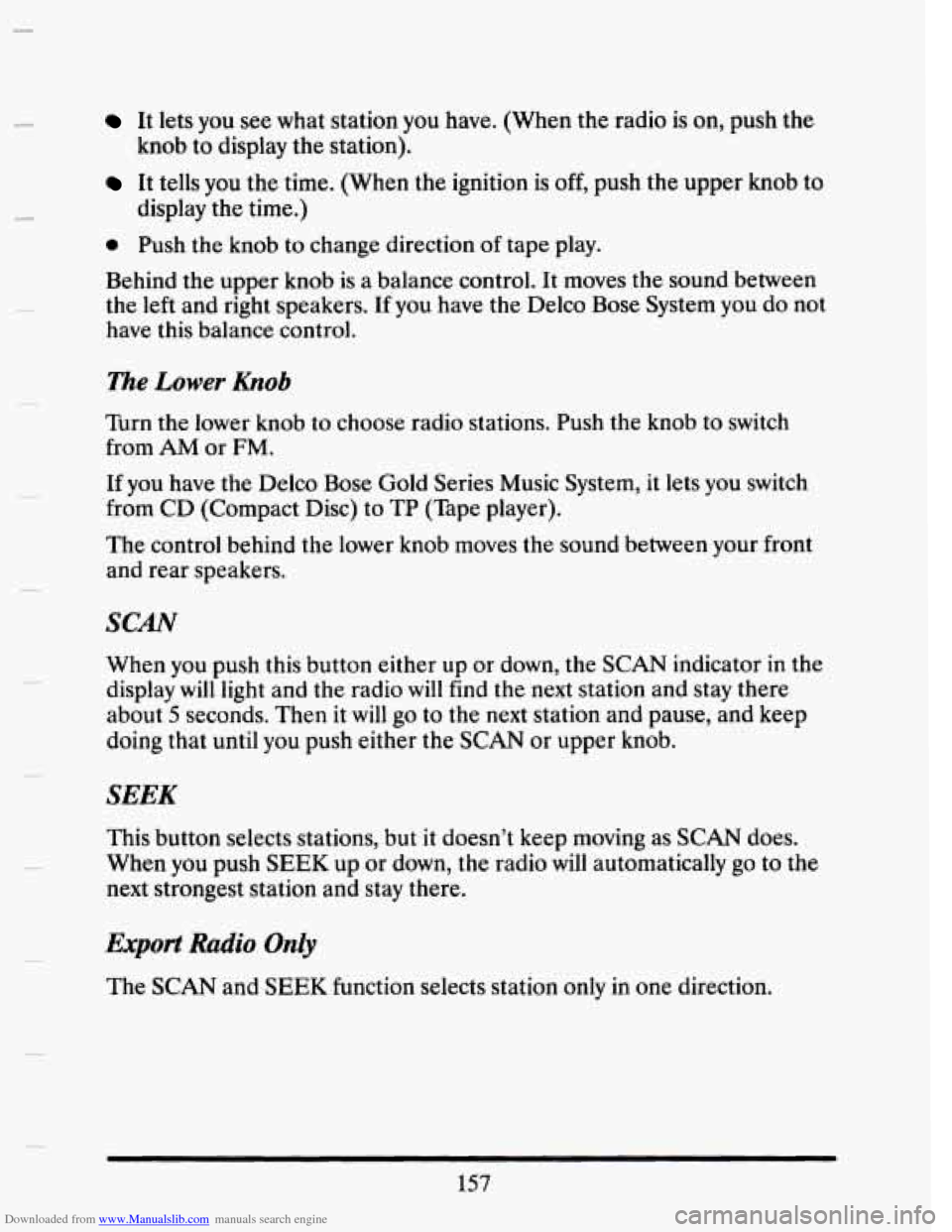
Downloaded from www.Manualslib.com manuals search engine li
L
It lets you see what station you nave. (When the radio is on, push the
knob to display the station).
It tells you the time. (When the ignition is off, push the upper knob to
display the time.)
0 Push the knob to change direction of tape play.
Behind the upper knob
is a balance control. It moves the sound between
the left and right speakers.
If you have the Delco Bose System you do not
have this balance control.
The Lower Knob
Turn the lower knob to choose radio stations. Push the knob to switch
from
Ah4 or FM.
If you have the Delco Bose Gold Series Music System, it lets you switch
from CD (Compact Disc) to TP (Tape player).
The control behind the lower knob moves the sound between your front
and rear speakers.
SCAN
When you push this button either up or down, the SCAN indicator in the
display will light and the radio
will find the next station and stay there
about
5 seconds. Then it will go to the next station and pause, and keep
doing that until
you push either the SCAN or upper knob.
SEEK
This button selects stations, but it doesn’t keep moving as SCAN does.
When you push
SEEK up or down, the radio will automatically go to the
next strongest station and stay there.
Export Radio Only
The SCAN and SEEK function selects station only in one direction.
157
Page 172 of 407
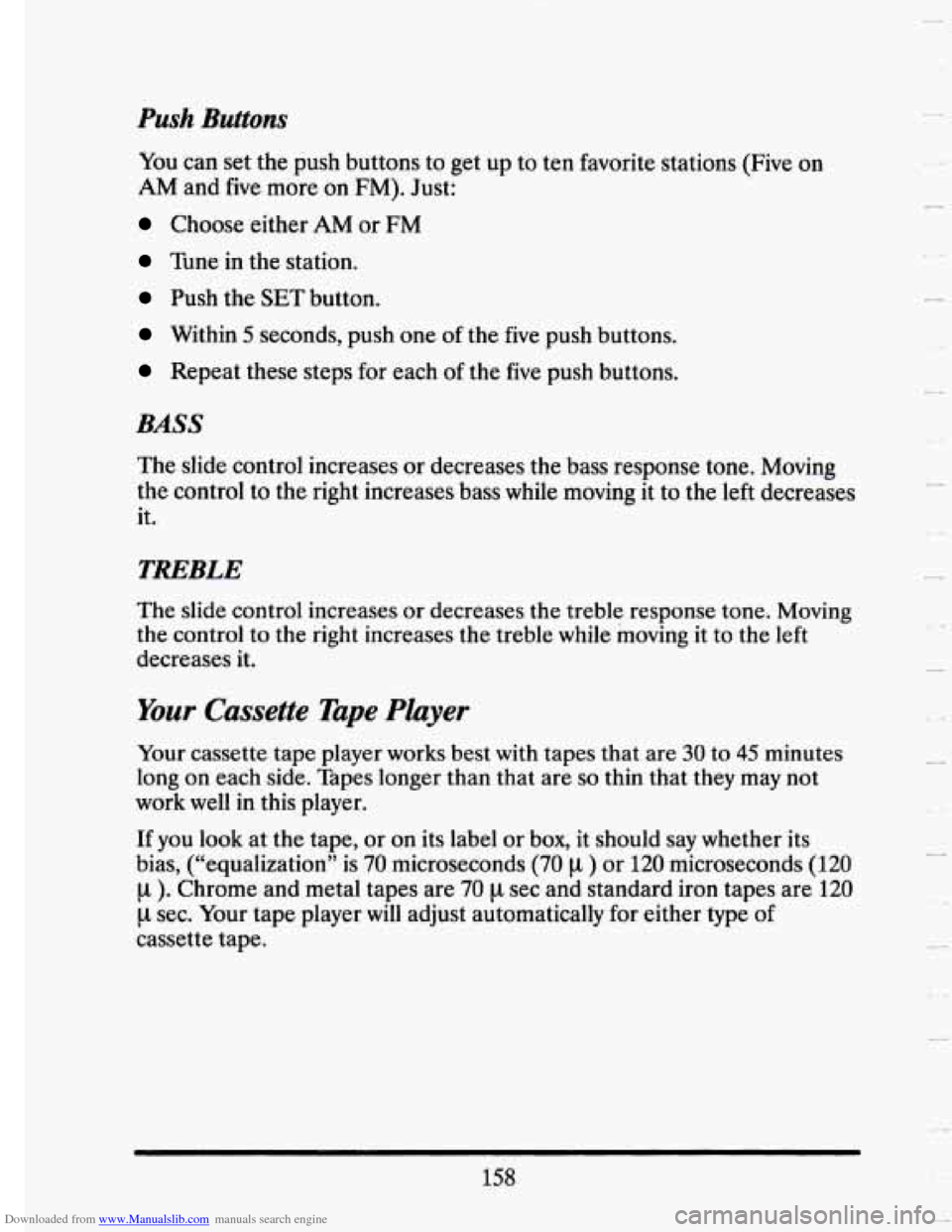
Downloaded from www.Manualslib.com manuals search engine Push Buttons
You can set the push buttons to get up to ten favorite stations (Five on
AM and five more on FM). Just:
Choose either AM or FM
Tune in the station.
Push the SET button.
Within 5 seconds, push one of the five push buttons.
Repeat these steps for each of the five push buttons.
BASS
The slide control increases or decreases the bass response tone. Moving
the control to the right increases bass
while moving it to the left decreases
it.
TREBLE
The slide control increases or decreases the treble response tone. Moving
the control to the
right increases the treble while moving it to the left
decreases it.
Your Cassette Tape Phyer
Your cassette tape player works best with tapes that are 30 to 45 minutes
long on each side. Tapes longer than that are
so thin that they may not
work well
in this player.
If you look at the tape, or on its label or box, it should say whether its
bias, (“equalization” is
70 microseconds (70 p ) or 120 microseconds (120
p ). Chrome and metal tapes are 70 p sec and standard iron tapes are 120
p sec. Your tape player will adjust automatically for either type of
cassette tape.
158
Y
CI
Y
Y
Page 173 of 407

Downloaded from www.Manualslib.com manuals search engine To Play A Cassette Tape
0 Turn the radio on.
0 Insert the cassette through the tape door. (The “TAPE” indicator in
the display will light.)
If
you hear nothing or hear just a garbled sound, the cassette may not be
in squarely. Push the
EJCT button to remove the tape and start over. The
tape equalization is automatically sensed and set. Inserting the cassette
also automatically disables
DNR@* and activates DOLBY@ noise
reduction.
DNR@ is the Dynamic
Noise Reduction. It helps remove background hiss
noise from the radio.
Once the tape is playing, use the upper and lower knobs to adjust the
volume and balance, just as
you do for the radio. Push the upper knob
to change tape direction.
The arrow in the display show which
direction the tape is being played.
FWD (Forward)
Push the FWD button to move forward rapidly to another part of the
tape. The radio will play during fast forward.
To stop the tape push the
same button and the tape will start to play again.
REV (Reverse)
Push the REV button to move the tape rapidly backward. To stop the
tape, push
the same button lightly or any of the other buttons. The radio
will play during this reverse function.
To go
from one side of the tape to the other, push in the upper knob on
your radio. To remove the tape, push
EJCT. The tape can be ejected when
the ignition is turned off.
*DNR@ is a registered trademark of National Semiconductor
Corporation.
159
Page 174 of 407
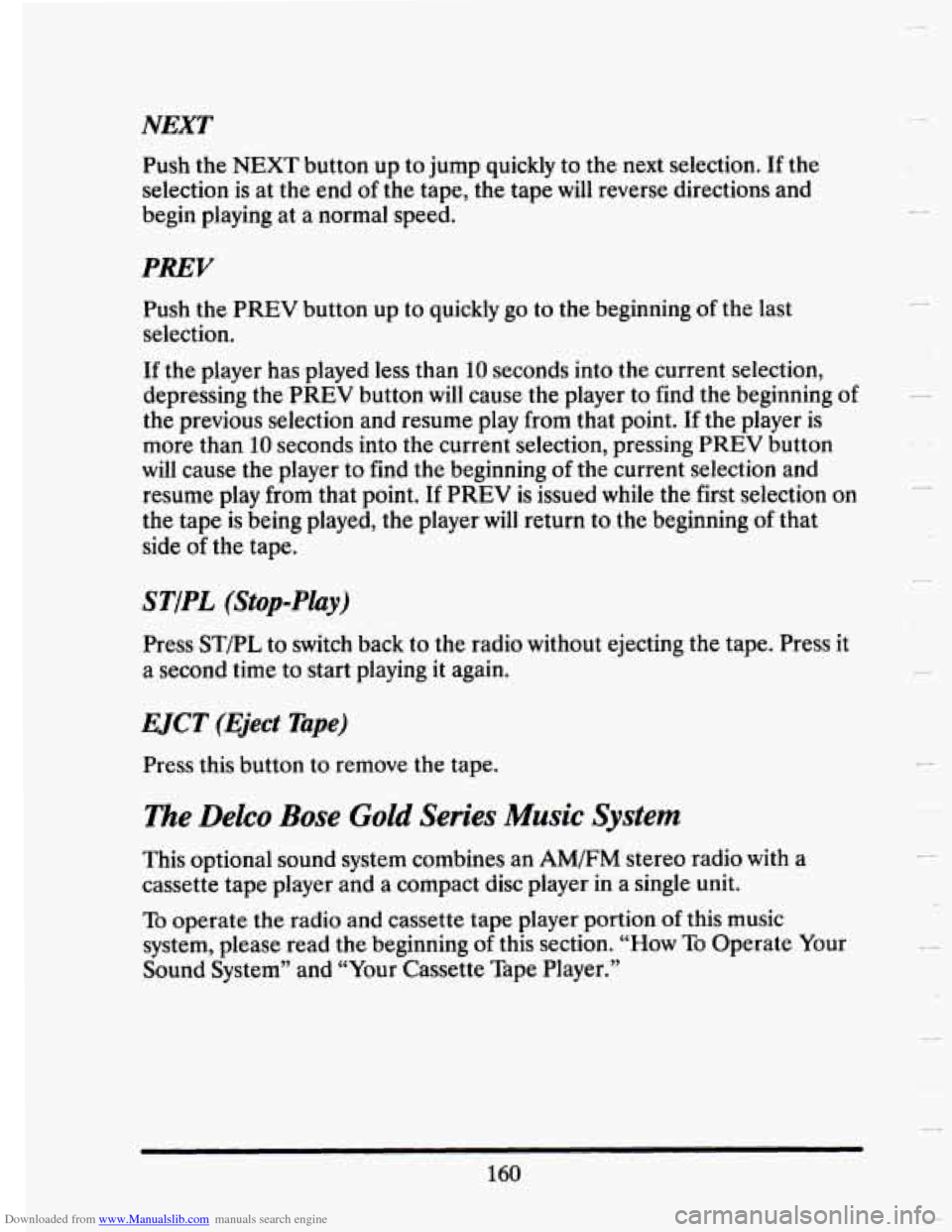
Downloaded from www.Manualslib.com manuals search engine NEXT
Push the NEXT button up to jump quickly to the next selection. If the
selection is at the end
of the tape, the tape will reverse directions and
begin playing at a normal speed.
PREY
Push the PREV button up to quickly go to the beginning of the last
selection.
If the player has played less than 10 seconds into the current selection,
depressing the
PREV button will cause the player to find the beginning of
the previous selection and resume play from that point.
If the player is
more than
10 seconds into the current selection, pressing PREV button
will cause the player to find the beginning of the current selection and
resume play from that point. If
PREV is issued while the first selection on
the tape is being played, the player
will return to the beginning of that
side
of the tape.
STfPL (St~p-Play)
Press STPL to switch back to the radio without ejecting the tape. Press it
a second time to start playing it again.
EJCT (Eject Tape)
Press this button to remove the tape.
The Delco Bose Gold Series Music System
This optional sound system combines an AM/FM stereo radio with a
cassette tape player and a compact disc player
in a single unit.
To operate the radio and cassette tape player portion of this music
system, please read the beginning
of this section. “How To Operate Your
Sound System” and “Your Cassette Tape Player.”
160
Y
c
Page 175 of 407
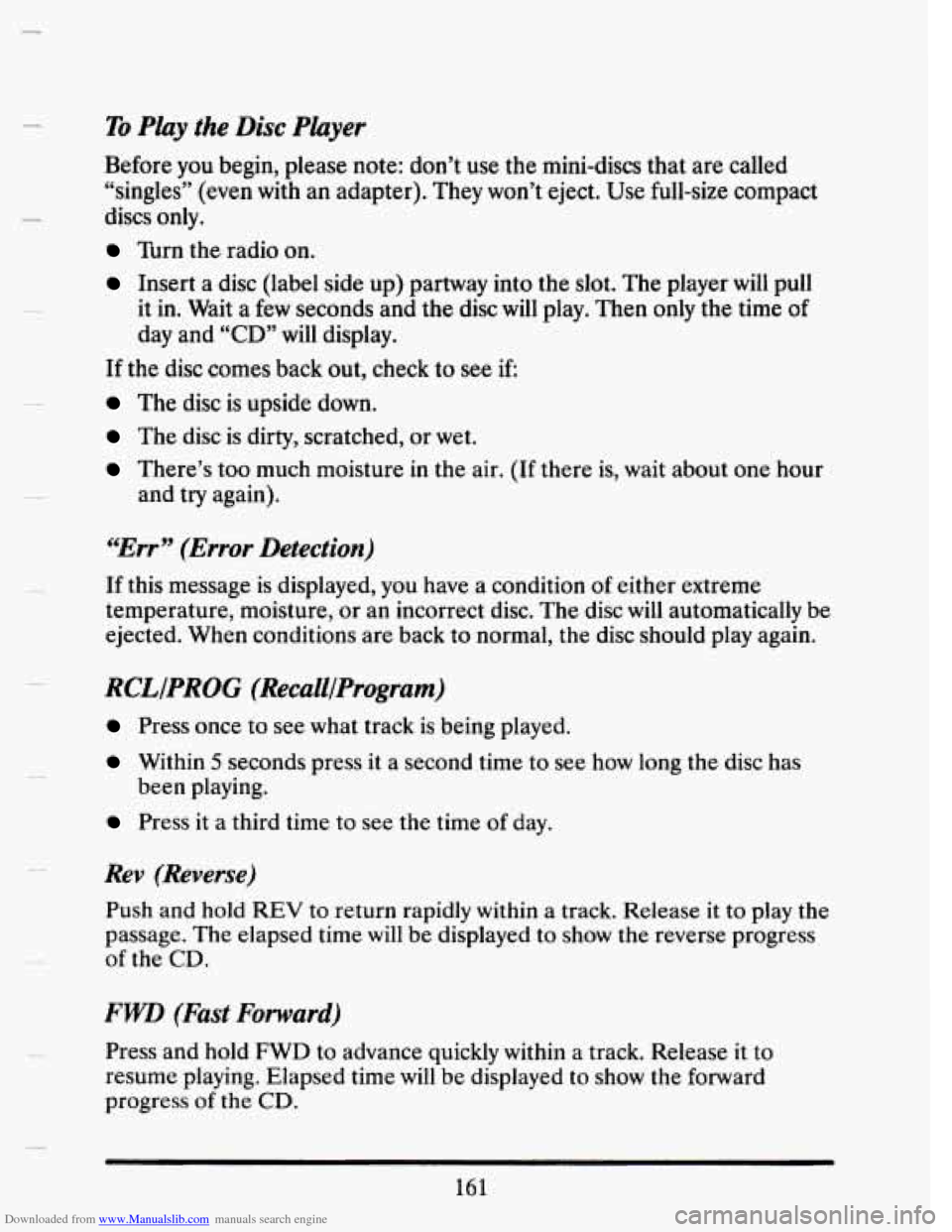
Downloaded from www.Manualslib.com manuals search engine To Play the Disc Player
Before you begin, please note: don’t use the mini-discs that are called
“singles”
(even with an adapter). They won’t eject. Use full-size compact
discs
only.
Turn the radio on.
Insert a disc (label side up) partway into the slot. The player will pull
it in. Wait a
few seconds and the disc will play. Then only the time of
day and “CD” will display.
If the disc comes back out, check to see if
The disc is upside down.
The disc is dirty, scratched, or wet.
There’s too much moisture in the air. (If there is, wait about one hour
and try again).
“Err” (Error Detection)
If this message is displayed, you have a condition of either extreme
temperature, moisture,
or an incorrect disc. The disc will automatically be
ejected. When conditions are back to normal, the disc should play again.
RCLIPROG (RecalllProgram)
Press once to see what track is being played.
Within 5 seconds press it a second time to see how long the disc has
Press it a third time to see the time of day.
been playing.
Rev (Reverse)
Push and hold REV to return rapidly within a track. Release it to play the
passage. The elapsed time
will be displayed to show the reverse progress
of the
CD.
FWD (Fast Forward)
Press and hold FWD to advance quickly within a track. Release it to
resume playing. Elapsed time
will be displayed to show the forward
progress
of the CD.
161
Page 176 of 407
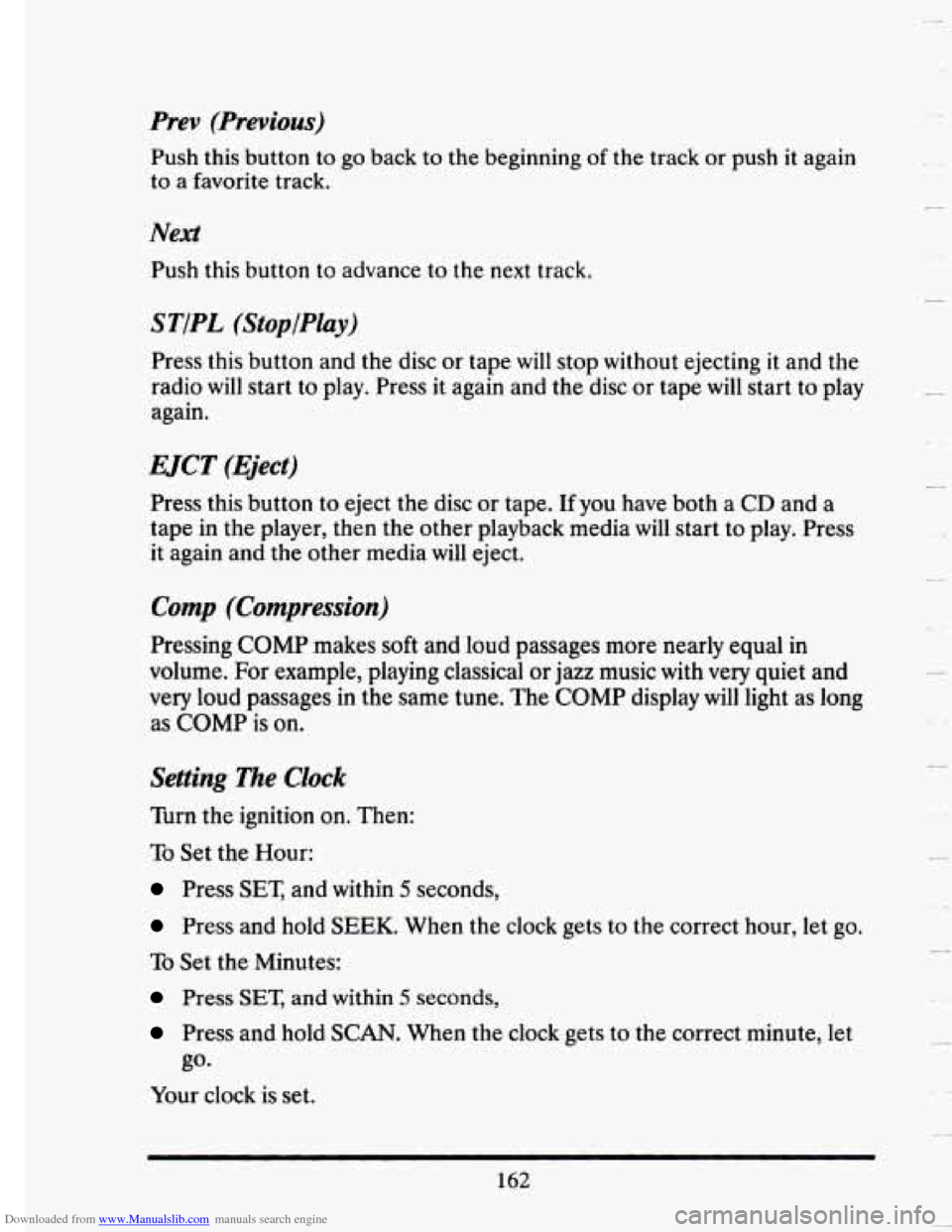
Downloaded from www.Manualslib.com manuals search engine Prev (Previous)
Push this button to go back to the beginning of the track or push it again
to a favorite track.
Next
Push this button to advance to the next track.
STiPL (StopfPlay)
Press this button and the disc or tape will stop without ejecting it and the
radio
will start to play. Press it again and the disc or tape will start to play
again.
EJCT (Eject)
Press this button to eject the disc or tape. If you have both a CD and a
tape in the player, then the other playback media
will start to play. Press
it again and the other media will eject.
Comp (Compression)
Pressing COMP makes soft and loud passages more nearly equal in
volume. For example, playing classical
or jazz music with very quiet and
very loud passages
in the same tune. The COMP display will light as long
as
COMP is on.
Setting The Clock
Turn the ignition on. Then:
To Set the Hour:
Press SET, and within 5 seconds,
Press and hold SEEK. When the clock gets to the correct hour, let go.
To Set the Minutes:
Press SET, and within 5 seconds,
Press and hold SCAN. When the clock gets to the correct minute, let
Your clock is set.
go.
162
u
Page 177 of 407
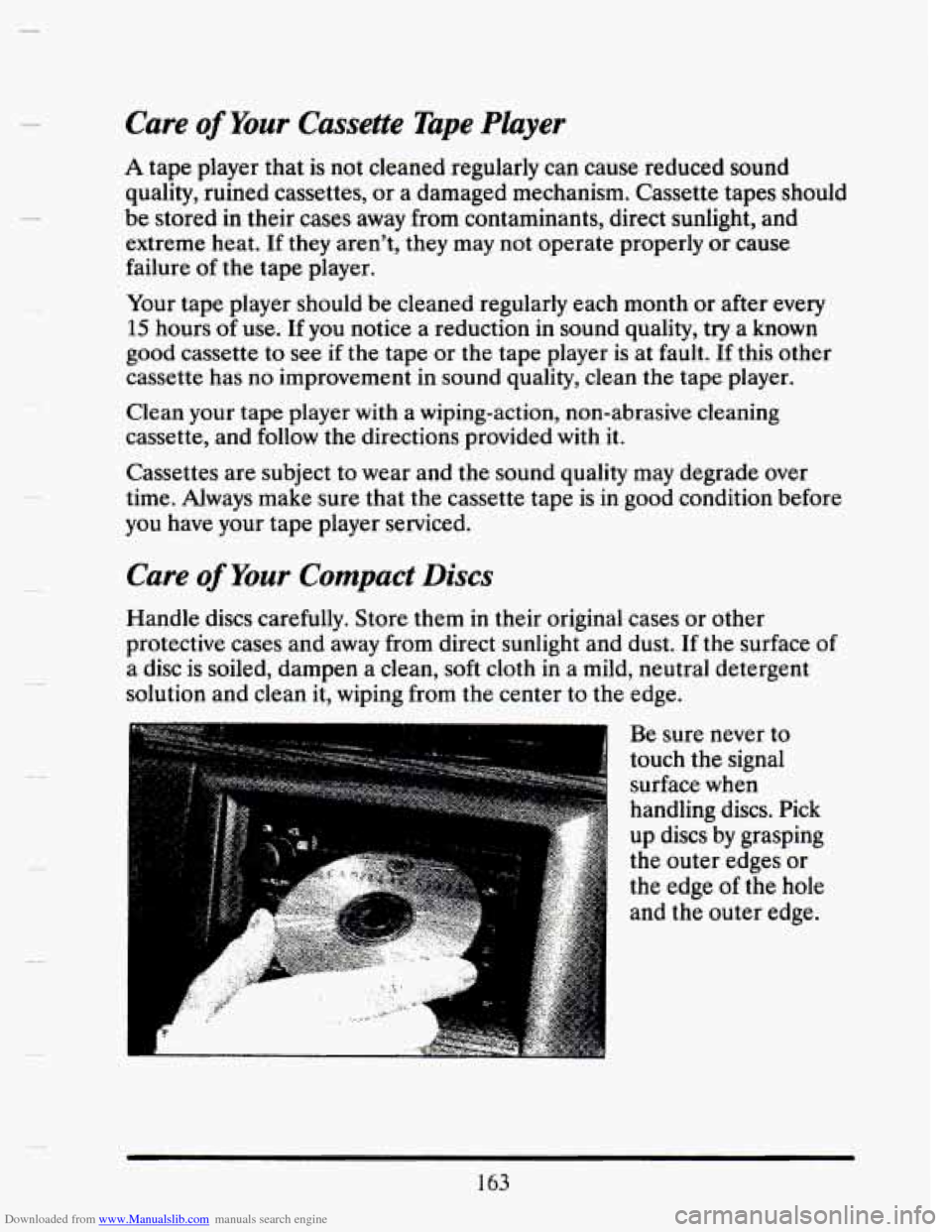
Downloaded from www.Manualslib.com manuals search engine 3
Care of Your Cassette Tape Player
A tape player that is not cleaned regularly can cause reduced sound
quality, ruined cassettes, or a damaged mechanism. Cassette tapes should
be stored
in their cases away from contaminants, direct sunlight, and
extreme heat.
If they aren't, they may not operate properly or cause
failure of the tape player.
Your tape player should be cleaned regularly each month or after every
15 hours of use. If you notice a reduction in sound quality, try a known
good cassette to see
if the tape or the tape player is at fault. If this other
cassette has no improvement
in sound quality, clean the tape player.
Clean your tape player
with a wiping-action, non-abrasive cleaning
cassette, and follow the directions provided
with it.
Cassettes are subject to wear and the sound quality may degrade over
time. Always make sure that the cassette tape is
in good condition before
you have your tape player serviced.
Care of Your Compact Discs
Handle discs carefully. Store them in their original cases or other
protective cases and away from direct sunlight
and dust. If the surface of
a disc is soiled, dampen a clean, soft cloth
in a mild, neutral detergent
solution and clean it, wiping from the center to the edge.
A
Be sure never to
touch the signal
surface when
handling discs. Pick
up discs
by grasping
the outer edges or
the edge
of the hole
and the outer edge.
163
Page 178 of 407

Downloaded from www.Manualslib.com manuals search engine Power Antenna Mast Care
Your power antenna will look its best and work well if it’s cleaned from
time
to time.
To Clean the Antenna Mast:
1. lbrn on the ignition and radio to raise the antenna to full mast
extension.
2. Dampen a clean cloth with mineral spirits or equivalent solvent.
3. Wipe cloth over the mast sections, removing any dirt.
4. Wipe dry with clean cloth before retracting.
5. Make the antenna go up and down by turning the radio or ignition on
6. Then repeat if necessary.
and
off.
NOTICE:
I Don’t lubricate the power antenna. Lubrication could damage
I
I
164
Page 179 of 407
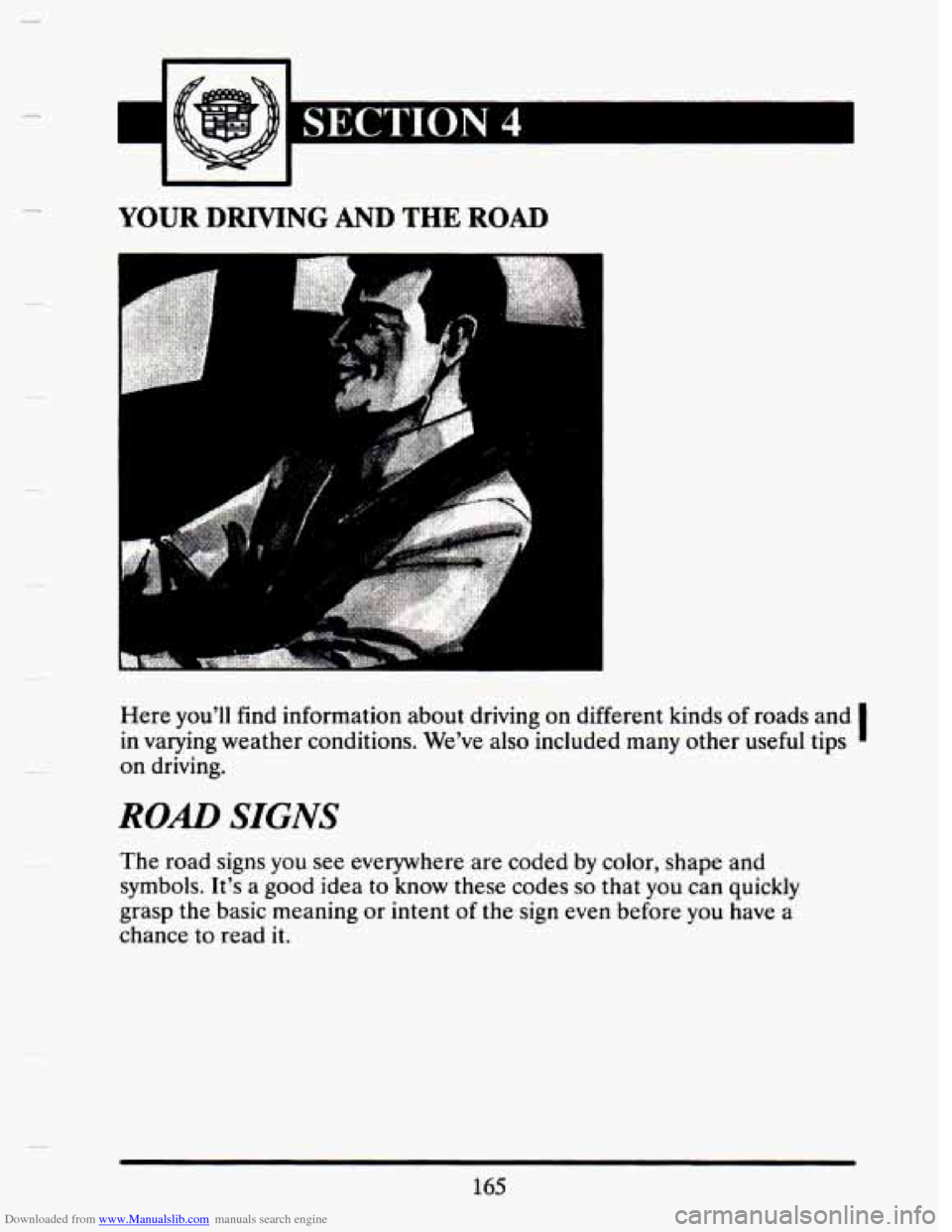
Downloaded from www.Manualslib.com manuals search engine I
YOUR DRIVING AND THE ROAD
P
Here you’ll find information about driving on different kinds of roads and
in varying weather conditions. We’ve also included many other useful tips
I
on driving.
RORD SIGNS
The road signs you see everywhere are coded by color, shape and
symbols. It’s a good idea
to know these codes so that you can quickly
grasp
the basic meaning or intent of the sign even before you have a
chance
to read it.
165
Page 180 of 407
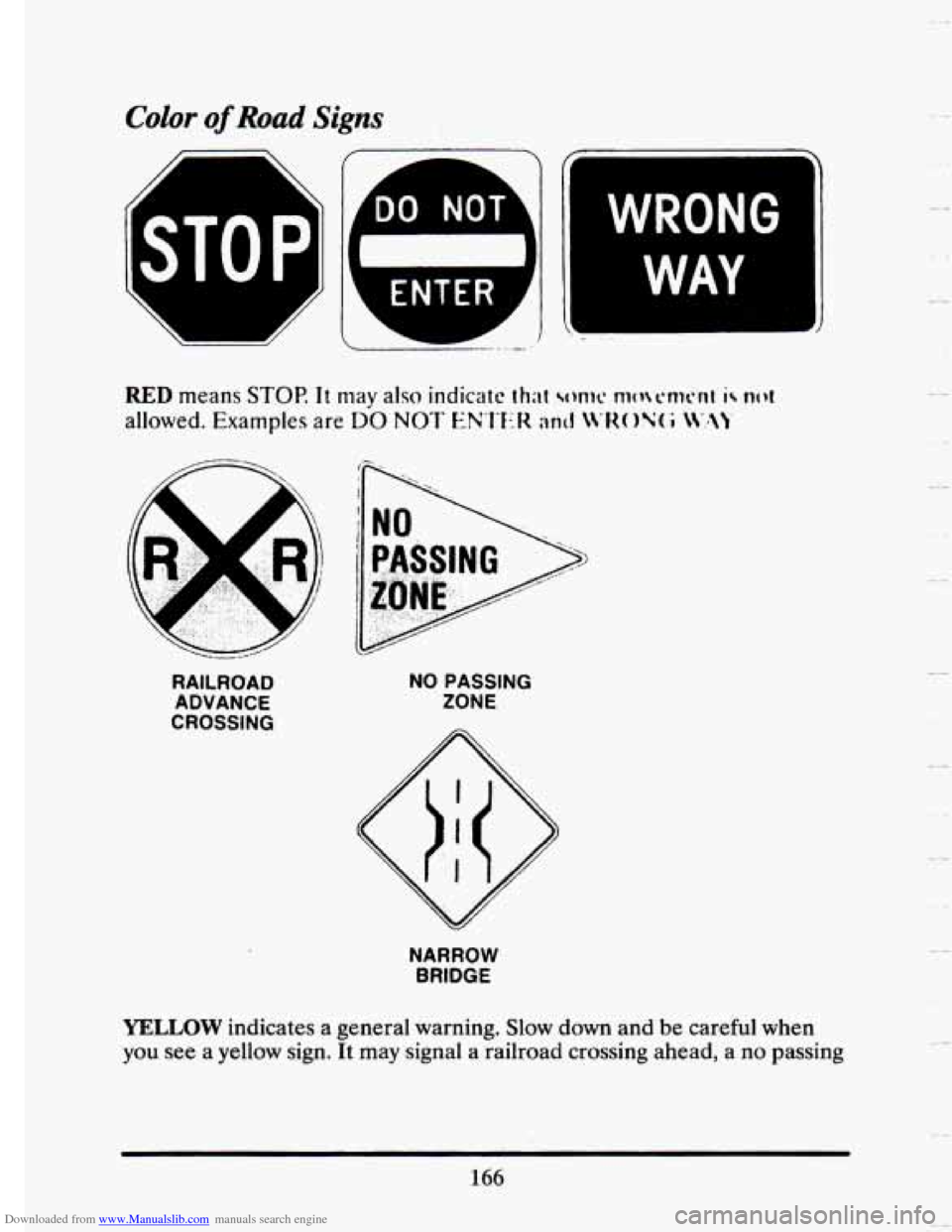
Downloaded from www.Manualslib.com manuals search engine Color of Road Signs
WRONG
WAY
RAILROAD ADVANCE
CROSSING NO
PASSING
ZONE
NARROW
BRIDGE
YELLOW indicates a general warning. Slow down and be careful when
you see
a yellow sign. It may signal a railroad crossing ahead, a no passing
166
.. -
-